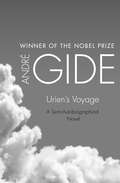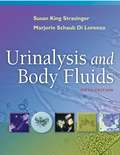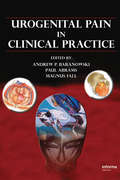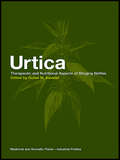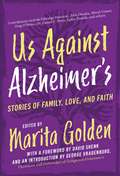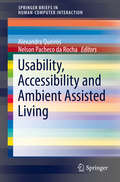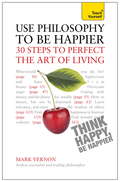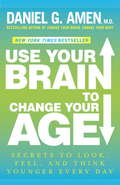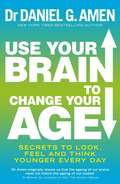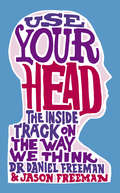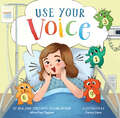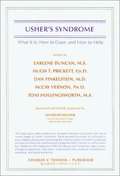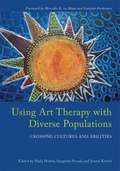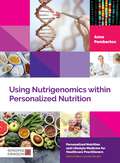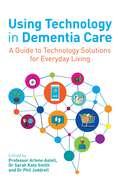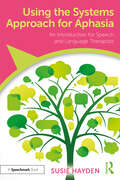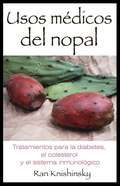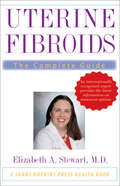- Table View
- List View
Urien's Voyage
by André GideNobel Prize–winning writer André Gide marks his voyage toward self-discovery in this imaginative allegorical work When Urien and his sailing companions begin their voyage, it is to places unknown and, perhaps, only dreamed. This allegorical masterpiece from André Gide, a key figure of French letters, deftly illustrates the techniques and doctrine of the Symbolist movement—and the dual nature of Gide&’s own psyche. Written at a crucial time in his artistic development, this imaginative work signals his gradual abandonment of acetic celibacy toward an embrace of pleasure and carnal desires, revealing a Gide more transparent in this early work than in his mature writings. Translator and scholar Wade Baskin annotates the work, connecting Gide&’s life and bibliography to the text.
Urien's Voyage
by André GideNobel Prize–winning writer André Gide marks his voyage toward self-discovery in this imaginative allegorical work When Urien and his sailing companions begin their voyage, it is to places unknown and, perhaps, only dreamed. This allegorical masterpiece from André Gide, a key figure of French letters, deftly illustrates the techniques and doctrine of the Symbolist movement—and the dual nature of Gide&’s own psyche. Written at a crucial time in his artistic development, this imaginative work signals his gradual abandonment of acetic celibacy toward an embrace of pleasure and carnal desires, revealing a Gide more transparent in this early work than in his mature writings. Translator and scholar Wade Baskin annotates the work, connecting Gide&’s life and bibliography to the text.
Urinalysis and Body Fluids (Fifth Edition)
by Susan King Strasinger Marjorie Schaub Di LorenzoThis thoroughly updated 5th Edition provides you with concise and carefully structured full-color instruction in the handling and analysis of non-blood body fluids. You will learn how to handle and preserve the integrity of body fluid specimens and how to keep yourself and your laboratory safe from infectious agents! Practical, focused, and reader friendly, this popular text teaches the theoretical and practical knowledge every clinical laboratory scientist needs to handle and analyze non-blood body fluids, and to keep you and your laboratory safe from infectious agents. The 5th Edition has been completely updated to include all of the new information and new testing procedures that are important in this rapidly changing field. Case studies and clinical situations show how work in the classroom translates to work in the lab.
Urogenital Pain in Clinical Practice
by Magnus Fall Paul Abrams Andrew Paul BaranowskiDeveloped by an authoritative and multidisciplinary team of contributors well-recognized for their dedication to the care of urogenital pain patients, this source addresses the latest clinical guidelines for the management of urogenital pain and covers the mechanisms and clinical treatment of pain syndromes of the urogenital area in both the male a
Urogynaecology for the MRCOG and Beyond
by Natalia Price Simon JacksonWhile the upper renal tract remains the sole preserve of the urologist, gynaecologists have traditionally been involved in the assessment and treatment of female lower urinary tract infection disorders. Childbirth is a major causal factor in urogynaecology, and women often present with a combination of menstrual, genital, urinary and colorectal symptoms which require a holistic approach. This book provides a comprehensive overview of the assessment and treatment of a range of urogynaecological problems: urinary incontinence; lower urinary tract symptoms; overactive bladder; recurrent urinary tract infection; haematuria; painful bladder syndrome and interstitial cystitis; pregnancy and the renal tract; ageing and urogenital symptoms; fistulae and urinary tract injuries; pelvic organ prolapse; colorectal disorders; obstetric anal sphincter injuries. It has been comprehensively updated to reflect current clinical practice and new research since publication of the original edition.
Urtica: The genus Urtica (Medicinal And Aromatic Plants - Industrial Profiles Ser. #Vol. 37)
by Gulsel M. KavalaliPlants from the genera Urtica, often better known as the stinging nettle, can be distinguished by their stinging hairs, and in some species, their serrated leaf edges. Historical records of the various uses of Urtica date back to at least the Bronze Age (3000-2000 BC). Nettles have traditionally been used as a nutritious food source particularly in
Us Against Alzheimer's: Stories of Family, Love, and Faith
by Marita GoldenThis groundbreaking multicultural anthology shares moving personal stories about the impacts of Alzheimer’s and dementia. An estimated 5.7 million Americans are afflicted by Alzheimer’s disease, including 10 percent of those over sixty-five, and it is the sixth leading cause of death. But its effects are more pervasive: for the nearly 6 million sufferers, there are more than 16 million family caregivers and many more family members. Alzheimer’s wreaks havoc not only on brain cells; it is a disease of the spirit and heart for those who suffer from it but also for their families. This groundbreaking anthology presents forty narratives, both nonfiction and fiction, that together capture the impact and complexity of Alzheimer’s and other dementias on patients as well as their caregivers and family. Deeply personal, recounting the wrenching course of a disease that kills a loved one twice—first they forget who they are, and then the body succumbs—these stories also show how witnessing the disease and caring for someone with it can be powerfully transformative, calling forth amazing strength and grace. The contributors, who have all generously donated their work, include Edwidge Danticat, Julie Otsuka, Elizabeth Nunez, Meryl Comer, Greg O’Brien, Dr. Daniel Potts, Sallie Tisdale, and Nihal Satyadev. Reflecting the diversity and global nature of the dementia crisis, this anthology is published in collaboration with UsAgainstAlzheimer’s.
Usability, Accessibility and Ambient Assisted Living
by Alexandra Queirós Nelson Pacheco da RochaWorldwide, the population ageing is a reality. The concept of Active Ageing, adopted by the World Health Organization, aims to guarantee quality ageing and appears as a strategy to solve this demographic challenge. The technological solutions might have a key role in the promotion of human functioning and in the mitigation of disabilities, particularly those resulting from the natural ageing process. This perspective is evident in the development of Ambient Assisted Living (AAL) solutions. In this context, it is relevant to know about the recent developments in AAL and discuss future trends and challenges in this area. One of the objectives of this book is to do a systematic literature review on AAL, not only considering the technology used, but also the health condition that is intended to improve. For this purpose, we consider the human functioning, in particular the conceptual model of International Classification of Functioning, Disability and Health (ICF). Considering that the ICF conceptual framework is accepted within the healthcare domain, the use of its concepts and terminologies to promote multidisciplinary approaches for AAL solutions development processes can help to overcome difficulties of communication between users, careers and technological developers. AAL solutions must consider in their development the needs of the person that will use AAL solutions. The development must be user-centred and usability questions cannot be forgotten. In addition, the acceptance of the AAL solutions is closely related to the quality of the systems, so it is necessary to appropriately assess these solutions.
Use Philosophy to be Happier: 30 Steps to Perfect the Art of Living
by Mark VernonHappiness. We all want it - but how can we get it? Author Mark Vernon has solved the problem by collecting the wisdom of the greatest minds in history and making their thinking on the important things in life accessible and, above all, practical. Full of everyday examples to make sometimes high-blown philosophy entertaining and relevant, this book shows you how you can crack the secret to living The Good Life.
Use Philosophy to be Happier: 30 Steps to Perfect the Art of Living
by Mark VernonHappiness. We all want it - but how can we get it? Author Mark Vernon has solved the problem by collecting the wisdom of the greatest minds in history and making their thinking on the important things in life accessible and, above all, practical. Full of everyday examples to make sometimes high-blown philosophy entertaining and relevant, this book shows you how you can crack the secret to living The Good Life.
Use Your Brain to Change Your Age
by Daniel G. AmenTHE FOUNTAIN OF YOUTH IS BETWEEN YOUR EARS.A healthy brain is the key to staying vibrant and alive for a long time, and in Use Your Brain to Change Your Age, bestselling author and brain expert Dr. Daniel G. Amen shares ten simple steps to boost your brain to help youlive longer, look younger, and dramatically decrease your risk for Alzheimer's disease.Over the last twenty years at Amen Clinics, Dr. Amen has performed more than 70,000 brain scans on patients from ninety different countries. His brain imaging work has taughthim that our brains typically become less active with age and we become more vulnerable tomemory problems and depression. Yet, one of the most exciting lessons he has learned is thatwith a little forethought and a brain-smart plan, you can slow, or even reverse, the aging process in the brain.Based on the approach that has helped thousands of people at Amen Clinics along with the most cutting-edge research, Dr. Amen's breakthrough, easy-to-follow antiaging program shows you how to:* Boost your memory, mood, attention,and energy* Decrease your risk for Alzheimer's andother forms of dementia* Eat to live longer* Reduce the outward signs of aging andmake your skin more beautiful* Promote the healing of brain damage dueto injury, strokes, substance abuse, andtoxic exposure* Dramatically increase your chances ofliving longer and looking younger**And much more.By adopting the brain healthy strategies detailed in Use Your Brain to Change Your Age, you can outsmart your genes, put the brakes on aging, and even reverse the aging process. If you change your brain, you can change your life--and your age.
Use Your Brain to Change Your Age: Secrets to Look, Feel, and Think Younger Every Day
by Daniel G. AmenTHE FOUNTAIN OF YOUTH IS BETWEEN YOUR EARS.A healthy brain is the key to staying vibrant and alive for a long time, and in Use Your Brain to Change Your Age, bestselling author and brain expert Dr. Daniel G. Amen shares ten simple steps to boost your brain to help youlive longer, look younger, and dramatically decrease your risk for Alzheimer's disease.Over the last twenty years at Amen Clinics, Dr. Amen has performed more than 70,000 brain scans on patients from ninety different countries. His brain imaging work has taughthim that our brains typically become less active with age and we become more vulnerable tomemory problems and depression. Yet, one of the most exciting lessons he has learned is thatwith a little forethought and a brain-smart plan, you can slow, or even reverse, the aging process in the brain.Based on the approach that has helped thousands of people at Amen Clinics along with the most cutting-edge research, Dr. Amen's breakthrough, easy-to-follow antiaging program shows you how to:* Boost your memory, mood, attention,and energy* Decrease your risk for Alzheimer's andother forms of dementia* Eat to live longer* Reduce the outward signs of aging andmake your skin more beautiful* Promote the healing of brain damage dueto injury, strokes, substance abuse, andtoxic exposure* Dramatically increase your chances ofliving longer and looking younger**And much more.By adopting the brain healthy strategies detailed in Use Your Brain to Change Your Age, you can outsmart your genes, put the brakes on aging, and even reverse the aging process. If you change your brain, you can change your life--and your age.
Use Your Brain to Change Your Age: Secrets to look, feel and think younger every day
by Dr Daniel G. AmenA healthy brain is the key to living longer and looking younger. In Use Your Brain to Change Your Age, clinical neuroscientist and bestselling author Dr Daniel G. Amen shares simple steps to boost your brain, helping you to look, feel and think younger. Based on the approach that has helped thousands of people at the Amen Clinics and the most up-to-date research collected from over 70,000 brain scans, Dr Amen's breakthrough programme leads you through ten simple anti-aging steps that will also dramatically decrease the risk for Alzheimer's disease. You will learn how to:- Boost your memory, mood, attention and energy- Decrease your risk of Alzheimer's and other forms of dementia- Reduce the outward signs of aging and make your skin more beautiful- Promote the healing of brain damage due to injury, strokes, substance abuse and toxic exposure- Dramatically increase your chances of living longer and looking younger
Use Your Head: A Guided Tour Of The Human Mind
by Dr Daniel Freeman Jason FreemanEver wondered what goes on up there? Why do we think, feel and act in the way we do? What makes us happy or sad, angry or anxious? The Freeman brothers unravel the secrets of the mind and explain the scientific facts behind our behaviour. Armed with key psychological insights you'll be able to apply them to everyday situations and understand why we are attracted to certain people or remember faces rather than names. Having trouble sleeping? Suffering from panic attacks? Use Your Head will pin-point your symptoms and give you practical advice on how to overcome these difficulties. Clear, concise and immediately relevant, this is essential reading.
Use Your Head: A Guided Tour of the Human Mind
by Jason Freeman Dr Daniel FreemanEver wondered what goes on up there? Why do we think, feel and act in the way we do? What makes us happy or sad, angry or anxious? The Freeman brothers unravel the secrets of the mind and explain the scientific facts behind our behaviour. Armed with key psychological insights you'll be able to apply them to everyday situations and understand why we are attracted to certain people or remember faces rather than names. Having trouble sleeping? Suffering from panic attacks? Use Your Head will pin-point your symptoms and give you practical advice on how to overcome these difficulties. Clear, concise and immediately relevant, this is essential reading.
Use Your Voice
by Alice Paul TapperFrom the author of the New York Times bestseller Raise Your Hand comes an important book about making your voice heard, especially when others refuse to listen.After a harrowing experience at the hospital, Alice Paul Tapper—daughter of CNN's Jake Tapper—shares her story with the help of some imaginary friends.When Alice wakes up with a terrible pain in her stomach, she's not sure what might be the cause. A doctor at the hospital asks her to pick which face on a numbered pain chart best shows the suffering that she's experiencing. The problem is, she's nervous and isn't sure. That's when the faces turn into imaginary friends who help her speak up about what she's feeling.This fictionalized version of Alice's real experience chronicles her struggle to get the right diagnosis after suddenly being struck with appendicitis. Caregivers and kids alike will benefit from reading this meaningful book about advocating for yourself during a medical emergency. With whimsical and comforting illustrations by Fanny Liem, the gentle telling of this true story will resonate with anyone who has ever struggled to be believed.
Usher's Syndrome: What It Is, How to Cope, and How to Help
by Earlene Duncan Hugh T. Prickett Dan Finkelstein Mccay Vernon Toni HollingsworthDescribes what Usher's syndrome is, how it impacts a person's life, and ways to cope with this dual disability.
Using Art Therapy With Diverse Populations: Crossing Cultures and Abilities
by Paula Howie Sangeeta Prasad Jennie Kristel Mercedes B. Ter Maat Gaelynn P. Wolf BordonaroArt is a recognised and effective form of therapy that is used all over the world. Yet are the approaches used as universal as the successes? Written with an international focus, this book considers how culture impacts the practice of art therapy in a variety of settings. With contributions from experienced art therapists who have worked in diverse environments, this book attempts to understand and highlight the specific cultural, subcultural and ethnic factors that inform art therapy treatment. It addresses variable factors including setting, population, environment and ability, and how they influence art therapy approaches. It also considers how cultural differences can impact physical art making through choices of color, symbol and metaphor. Each chapter provides a framework showing how art therapy techniques have been used in order to successfully work with distinct populations. This book will provide practitioners with ideas for how to adapt art therapy training and approaches to suit the setting and meet the needs of a huge range of populations. Full of informative case studies, this book will be invaluable reading for art therapists and students of art therapy.
Using Client Outcomes Information to Improve Mental Health and Substance Abuse Treatment
by Donald M. Steinwachs Laurie M. Flynn Grayson S. Norquist Elizabeth A. SkinnerA new way of assessing outcomes of care is the measurement of health status across its multiple dimensions of physical, mental and social domains of functioning.
Using Existing Platforms to Integrate and Coordinate Investments for Children
by Steve OlsonThe integration and coordination of health, education, nutrition, social protection, and other services have the potential to improve the lives of children and their caregivers around the world. However, integration and coordination of policies and programs affecting early childhood development can create both risks and benefits. In different localities, these services are more or less effective in achieving their objectives. They also are more or less coordinated in delivering services to the same recipients, and in some cases services are delivered by integrated multisectoral organizations. The result is a rich arena for policy analysis and change and a complex challenge for public- and private-sector organizations that are seeking to improve the lives of children. To examine the science and policy issues involved in coordinating investments in children and their caregivers, the Forum on Investing in Young Children Globally held a workshop in Hong Kong on March 14-15, 2015. Held in partnership with the Centre for Health Education and Health Promotion and Wu Yee Sun College of the Chinese University of Hong Kong, the workshop brought together researchers, policy makers, program practitioners, and other experts from 22 countries. This report highlights the presentations and discussions of the event.
Using Nutrigenomics within Personalized Nutrition: A Practitioner's Guide (Personalized Nutrition and Lifestyle Medicine for Healthcare Practitioners)
by Anne PembertonThis is the comprehensive guide to utilising nutrigenomics in clinical practice. A cutting-edge field, nutrigenomics examines the effects of foods on gene expression. From a comprehensive patient history and appropriate testing, practitioners can work with the patient to correct underlying biochemical imbalances that may predispose to a disease, using nutrigenomics as a guidance tool. The book covers everything a practitioner needs to know, from the difference between nutrigenomics and epigenetics to what to consider when incorporating nutrigenomics with functional medicine. The book is highly practical, guiding the reader through the realities of using genetic testing in clinical practice.
Using Technology in Dementia Care: A Guide to Technology Solutions for Everyday Living
by Sarah Smith Arlene Astell Phil JoddrellMany new pieces of technology can be beneficial to individuals living with dementia, including both hardware and software. This straightforward guide summarises the current research on this growing topic, and gives practical advice on how available technology can be used to improve the everyday lives of people with dementia.Looking at a range of available products, such as off-the-shelf computers and smartphones, to dementia specific applications and programs, it also addresses some common obstacles and barriers faced when introducing technology in dementia care. The past twenty years have seen an array of technologies developed to improve the day-to-day lives of people with dementia; this guide shows how they can be effectively used.
Using the Systems Approach for Aphasia: An Introduction for Speech and Language Therapists
by Susie HaydenUsing the Systems Approach for Aphasia introduces therapists to systems theory, exploring the way in which a holistic method that is already a key part of other health and social care settings can be employed in aphasia therapy. Detailed case studies from the author’s own extensive experience demonstrate how systemic tools can be incorporated into practice, offering practical suggestions for service delivery and caseload management in frequently overloaded community health services. Exploring the treatment process from first encounters, through the management of goals and attainments, to caring for patients after therapy has ended, the book demonstrates a method of delivering therapy in a way that will better serve the people who live with aphasia and their families, as well as the clinician themselves. Key features of this book include: • An accessible overview of systems theory and its use in aphasia therapy. • Consideration of how current popular ideas such as self-management, holistic rehabilitation and compassion focussed therapy can be incorporated to provide the best treatment. • Guidance on when and how to involve families based on case studies. • Case studies throughout to fully illustrate systemic approaches. An essential resource for both students and seasoned clinicians, the theory explored in this book will provide a fresh approach to therapy and new skills for working with people with aphasia and their families.
Usos médicos del nopal: Tratamientos para la diabetes, el colesterol y el sistema inmunológico
by Ran KnishinskyLa primera guía completa a los usos y las propiedades naturales de sanación del nopal • Examina las investigaciones científicas que promueven el nopal como un remedio natural para la diabetes y el colesterol y analiza además su uso en el tratamiento de la obesidad, los trastornos gastrointestinales, las afecciones de la piel y las infecciones virales • Incluye 24 recetas con el nopal, desde el pan de tuna hasta el caramelo de nopal El nopal --una planta que tiene la distinción de ser al mismo tiempo hortaliza, fruta y flor-- está destinado a ser la próxima gran superestrella de los remedios botánicos, como lo han sido la hierba de San Juan y la equinácea. Desde hace cientos de años ha sido un alimento básico en las dietas de los pueblos de la región suroeste de los Estados Unidos, del Oriente Medio, partes de Europa y África y América Central y del Sur, y se ha utilizado como panacea para más de cien dolencias distintas. Más recientemente, ha sido objeto de pruebas e investigaciones relacionadas con el nivel de colesterol en sangre, patrocinadas por la Asociación Estadounidense de Cardiología, y se utiliza en el tratamiento de la obesidad, trastornos gastrointestinales y afecciones de la piel. El libro contiene una sección en la que se detallan los productores de alimentos naturales que distribuyen el nopal, así como un capítulo de recetas en el que se presentan 24 platos tradicionales y modernos en los que se utilizan las tunas y nopales.
Uterine Fibroids: The Complete Guide (A Johns Hopkins Press Health Book)
by Elizabeth A. StewartProviding the most reliable and up-to-date information on this very common and difficult disorder, Dr. Stewart helps women understand uterine fibroids and make the best possible choices about their care.You've called in sick today. Your back and legs hurt. Your abdomen is bloated and more than a little uncomfortable. You are having your period, and the bleeding is so heavy you can't even think about leaving the house. You have uterine fibroids.One in every four women see their lives affected by uterine fibroids, which can cause heavy bleeding, abdominal bloating, pain, and infertility. The symptoms can be mildly annoying or life altering in severity. Until recently, hysterectomy was the only way to cure fibroids, and each year more than 200,000 hysterectomies are performed in the United States to treat these noncancerous growths. But hysterectomy isn’t always the best solution. The procedure can be devastating for women who were planning to get pregnant, and it is a significant surgery for anyone. In this comprehensive and compassionate guide, Dr. Elizabeth A. Stewart helps women understand the treatment options now available.An internationally recognized expert on fibroids, Dr. Stewart describes all the available medical and surgical treatments as well as alternative and complementary therapies. In addition to hysterectomy, she explains uterine artery embolization (UAE), noninvasive focused ultrasound (FUS), and innovative hormone treatments. Simple diagrams and photographs illustrate the condition—and its treatment. Dr. Stewart encourages women with fibroids to learn as much as they can before choosing a treatment plan. Providing the most reliable and up-to-date information on this very common and difficult disorder, she helps women understand uterine fibroids and make the best possible choices about their care.
